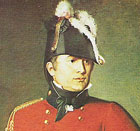Colonial Wars |
American Wars |
General Robert Ross
Robert Ross was born 1766 Rostrevor, County Down, Kingdom of Ireland and died on September 12, 1814 in Baltimore, Maryland. He was a British Army Officer during the War of 1812
 |
| NAME |
| Ross, Robert |
| BORN |
| 1766 Rostrevor, County Down, Kingdom of Ireland |
| DIED |
| September 12, 1814 Baltimore, Maryland |
| ARMY |
| British |
Ross was born in Rostrevor, County Down, Kingdom of Ireland to Major David Ross, an officer in the Seven Years' War and his mother, half-sister to the Earl of Charlemont. He was educated at Trinity College, Dublin and joined the 25th Regiment of Foot as an ensign in 1789.
He fought as a junior officer at the battles of Krabbendam in the Netherlands in 1799 and the Battle of Alexandria in Egypt in 1801. In 1803 he was promoted to major and given command of the 20th Regiment of Foot. He next fought at the Maida in the Kingdom of Naples in 1806. He was promoted to Lieutenant–Colonel at the end of 1808 and fought in the Battle of Corunna in Spain in early 1809. In 1810, Ross was made a full Colonel as well as aide-de-camp to the king.
He was sent in 1813 to serve under Arthur Wellesley in the Peninsular War and commanded his regiment at the battles of Vittoria, Roncesvalles and the Sorauren in that year. He was seriously wounded in the left side of his neck at the Battle of Orthes, on February 27, 1814, and had just returned to service when given command of an expeditionary force to the United States.
Ross sailed to North America as a Major General to take charge of all British troops off the east coast of the United States. He personally led the British troops ashore in Benedict, Maryland and marched through Upper Marlboro, Maryland to the attack on the Americans at the Battle of Bladensburg on August 24, 1814, causing the hastily organised militia of the American army to collapse into a rout. Moving on from Bladensburg, Ross moved on to nearby Washington DC and was fired upon, his horse was shot from under him. The public buildings of the city, including the United States Capitol and the White House were burned as retaliation for the destructive American raids into Canada, most notably the Americans' Burning of York (modern Toronto) in 1813.
Ross then was persuaded to attack Baltimore, Maryland. His troops landed at the southern tip of the Patapsco Neck peninsula at North Point, twelve miles from the city, on the morning of September 12, 1814. On route to what would be the Battle of North Point, a part of the larger Battle of Baltimore, the British encountered American skirmishers and Ross rode forward to personally direct his troops. An American sniper shot him through the right arm into the chest. According to Baltimore tradition, two American riflemen, Daniel Wells and Henry McComas, aged 18 and 19, respectively, were credited with killing Ross. Ross died while being transported back to the fleet.
After his death, the general's body was stored in a barrel of 129 gallons (586 l) of Jamaican rum aboard HMS Tonnant. When she was diverted to New Orleans for the forthcoming battle, the body was later shipped on the British ship HMS Royal Oak to Halifax, Nova Scotia where his body was interred on September 29, 1814 in the Old Burying Ground.
He is commemorated by a 100 ft granite obelisk near the shoreline of Carlingford Lough in the Ross home village of Rostrevor, County Down in Northern Ireland as well as by a monument in St. Paul's Cathedral, London.
Neither Ross or his immediate descendants were knighted or received a title of nobility. However, his descendants were given an augmentation of honour to the Ross armorial bearings (namely, a second crest in which an arm is seen grasping the stars and stripes on a broken staff) and the family name was changed to the victory title Ross-of-Bladensburg, which was granted to his widow.
In honour of Washington DC's history there is also a portrait of Ross in the capital's rotunda.
